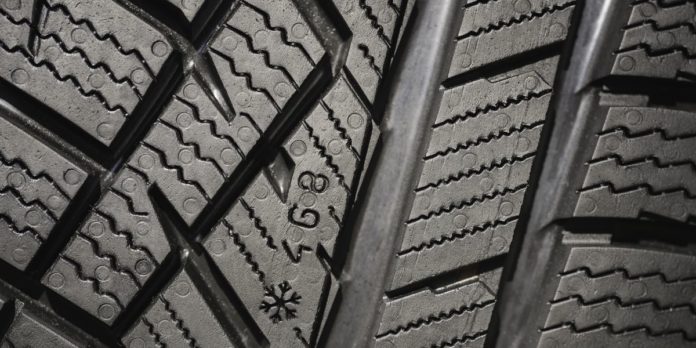Of the over 6.1 million traffic accidents that occur in the U.S. each year, approximately 11 percent happen during inclement weather, according to NHTSA’s most recent data. That’s an annual mix of 700,000 crinkled-up hoods, busted windshields, and accidents resulting in property damage, injury, or even death, caused by tiny pieces of precipitation. A freak ice or snowstorm ahead of your seasonal tire swap could spell disaster. That’s just one reason why Nokian (among other manufacturers) has combined its winter and all-season tire technology to produce a suitable option for heat and heavy rain or snow, promising to handle conditions all-seasons won’t and often at a wider temperature range than dedicated winter rubber can.
Nokian’s New Tire
The new Nokian Tyres Remedy WRG5, which is on sale today for approximately $130 to $290 each, is available in 70 sizes for wheels between 15 and 20 inches. The “WR” designates its connection for poor weather environments, and the “G5” shows that this is the fifth iteration of this naming convention, despite the WRG5 actually being the sixth-generation all-weather product from the company.
Nokian touts this new tire as suitable for sunshine, rain, slush, and snow, one with a compound that responds better to warmer temperatures while maintaining similar grip properties of traditional winter tires, which, unlike all-season rubber, is specifically designed to handle temperatures below 45 degrees Fahrenheit.
The Nokian Remedy WRG5 uses an asymmetrical tread and comes with Nokian’s Pothole Protection warranty, which offers free replacement of a tire for a year after purchase if it cannot be repaired. The Remedy WRG5 has a 60,000-mile treadwear warranty and comes with the company’s new “Electric Fit” symbol, which is simply there to illustrate it’s designed with heavy electric vehicles in mind. Of course, they’ll still roll forward and backward if installed on a gas-powered rig.
To achieve that goal of offering a tire that can handle a more dynamic range of weather, the Remedy has specific design elements that help back up its claim. The tread surface is a mix of tread blocks with sipping for snow grip with depth and varying interlocking zig-zag patterns that especially help with stability. Other grooves are designed to effectively evacuate water in rainy or slushy conditions, and there are even smaller “support blocks” that claim to help reinforce and stiffen up tread built specifically for winter conditions, during use on dry or higher-temp roads.
The Beauty of All-Weather Tires
It’s easy to get confused in the marketing lingo that muddies the difference between all-weather and all-season tires. The names sound like synonyms for each other, but on pavement, only the all-weather choice wears the three-peak mountain snowflake (3PMSF) certification found on tires specifically tested on snow. So why bother with an all-weather option and buy a set of winter tires and drive them through the summer instead? Well, as our friends at Tire Rack explained, “Rubber compounds are tuned for the ambient temperatures the tires are designed to encounter. Summer tires are best for warm conditions, and winter/snow tires are best for cold.”
We haven’t sampled Nokian’s Remedy tires yet, but we have installed all-weather tires from other brands on a select few long-term test cars we continue to experience, test, write, and report on for 40,000 miles. We’ve only experienced a weekend of snow and freezing weather during the most recent winter months here in Michigan, but our 2023 Honda Accord Hybrid Touring (Bridgestone WeatherPeak) and 2023 Mazda CX-90 S Premium Plus (Pirelli Scorpion WeatherActive) currently have all-weather tires installed.
Other long-term cars, such as the electric 2023 Hyundai Ioniq 5 and 2022 Volkswagen Golf GTI roam the frosty streets using Nokian Hakkapeliitta tires. The Hakkapeliitta R5 EV tires used by the Ioniq 5 feature an ice-rating symbol, which is a newly added designation; only tires that completed a braking test on ice are eligible to carry it.
While many of the cars we review and test for publication—as well as the personal vehicles of Car and Driver editors—do alternate between a set of winter and summer tires as temperatures change, it would be far more convenient to coordinate rotating and balancing a single set based on the manufacturer’s suggested maintenance intervals. Especially in situations where the drive to work becomes a survival adventure through a winter wonderland.
Yes, he’s still working on the 1986 Nissan 300ZX Turbo project car he started in high school, and no, it’s not for sale yet. Austin Irwin was born and raised in Michigan, and, despite getting shelled by hockey pucks during a not-so-successful goaltending career through high school and college, still has all of his teeth. He loves cars from the 1980s and Bleu, his Great Pyrenees, and is an active member of the Buffalo Wild Wings community. When Austin isn’t working on his own cars, he’s likely on the side of the highway helping someone else fix theirs.

